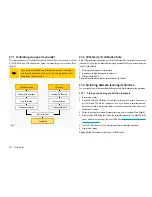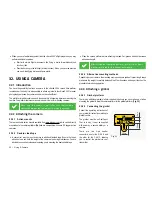
Flight Modes |
39
30.6.2 Principle explained
In traditional flying, knowing the relative position of the helicopter to the pilot (transmitter)
is crucial as stick input (except for throttle) directly affects the course. That is, if the
helicopter’s nose faces the pilot and they apply aileron, elevator, or rudder, behaviour is
essentially reversed. In case of loss of orientation the pilot may inadvertently crash the
helicopter.
When active, I.R.P.C solves this problem by registering the »NovaX 350’s take-off position
on motor start. All stick input is translated relatively to the take-off position, regardless of the
»NovaX 350’s position in flight. In other words, if the pilot takes off with the »NovaX 350’s
nose facing away from them, stick input always will affect the course relative to the take-off
position.
[ Fig. 18 ]
illustrates this priciple based on a mode 2 transmitter.
Mode 2
A
- Take-off position
B
- I.R.P.C. On
Mode 2
Fig. 18
[ Fig. 18 ]
:
[A]
denotes the take-off position and
[B]
the behaviour when I.R.P.C. is on. In
[B]
the
»NovaX 350 has been turned by 180° and moves to the right when aileron is applied,
whereas in traditional flying it would move to the left. This is because all input is translated
relatively to the take-off position (
[A]
).
30.7 Activated sensors
Sensor
Application
Flight mode
Basic
Altitude
GPS
GNSS sensor
GPS
–
–
Barometer (atmospheric
pressure sensor)
Altitude
–
Acceleration sensor
Levelling
Gyro
Orientation
Summary of Contents for NovaX 350
Page 1: ...88012RC ArF 88014RC RtF NovaX 350 Operating instructions M1...
Page 2: ...2 EVER WONDERED WHAT INNOVATION LOOKS LIKE NovaX 350...
Page 21: ...Dimensions 21 22 2 Long legs 283 mm 283 mm 250 mm 241 mm 130 mm 2 0 3 m m 3 4 7 m m...
Page 27: ...Calibration 27 2 1 90 90 90 1 2 3 4 5 6 Fig 6...
Page 49: ...49...
Page 50: ...50...
Page 51: ...51...
Page 52: ...52 www rclogger com...














































